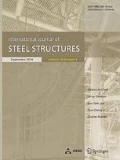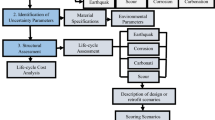Abstract
The influence of the near-fault ground motion on the response of long-span bridges must be considered as a critical factor for seismic design because the response indicates different aspects from existing earthquake characteristics. Also, it is important to note that the safety index for the risk assessment of long-span bridges is determined based on the minimum expected life-cycle cost E(LCC). In this study, earthquake characteristics are analyzed by creating elastic and inelastic response spectrums with actual measurement records (Chi-Chi earthquake records) and then the numerical analysis of the long-span bridge in Namhae, Korea is performed according to the increase and reduction of the member stiffness based on the standard design., the reliability evaluation of the long-span bridge considering aleatory uncertainties is performed on the basis of the combined results of static analysis and seismic response analysis. Also, the minimum LCC is estimated based on failure probabilities by the different alternative design. Because of epistemic uncertainties, the results of reliability evaluation and the LCC of optimal design are selected as random variables; the safety index, failure probability and expected minimum LCC are re-evaluated with regard to critical percentage values for a risk-averse design of the long-span bridge, and are presented graphically using cumulative percentages. It is, therefore, expected that this study will provide the basic information for the risk assessment and optimal design method in performing seismic design of the long-span bridge considering earthquake characteristics.
Similar content being viewed by others
References
Abrahamson, N. A. and Somerville, P. G. (1996). “Effects of the Hanging Wall and Foot Wall on Ground Motions Recorded during the Northridge Earthquake.” Bulletin of the Seismological Society of America, 86(1B), pp. S93–S99.
Alavi, B. and Krawinker, H. (2001). Effects of Near-Field Ground Motion on Building Structures. Department of Civil and Environmental Engineering, Stanford University, Progress Report on Year 1 Activities to a CUREE-Kajima Joint Research Program Phase III.
Ang, A. H-S. and De Leon, D. (2005). “Modeling and Analysis of Uncertainties for Risk-Informed Decisions in Infrastructures Engineering.” Journal of Structure and Infrastructure Engineering, 1(1), pp. 19–31.
Ang, A. H-S. and Tang, W. H. (2007). Probability Concepts in Engineering, 2nd Edition. John Wiley & Sons, Inc.
Ang, A. H-S. (2006). “Practical Assessments of Risk and its Uncertainty.” Proc. IFIP Workshop, Kobe, Japan.
Ang, A. H-S., Pires, J., and Lee, J. C. (1996). Reliability-Based Optimal Aseismic Design of Reinforced Concrete Building, Year 2. Final Technical Report of Research Project supported by CUREe/Kajima, Contract No. 19032.
Bolt, B. A. (1997). “Lost from the San Fernando Earthquake of February 9, 1971, by Paul C. Jennings.” Earthquake Spectra, 13(3), pp. 545–547.
Cho, H. N., Park, K. H., Hwang, Y. G., and Lee, K. M. (2004). “Practical Application of Life-Cycle Cost Effective Design and Rehabilitation of Bridges.” Corrosion Science and Technology, 3(2), pp. 72–80.
Chopra, A. K. (1995). Dynamics of Structures: Theory and Applications to Earthquake Engineering. Prentice-Hall, Inc.
Frangopol, D. M. and Lin, K. Y. (1997). “Life-Cycle Cost Design of Deteriorating Structures.” Journal of Structure Engineering, ASCE, 123(10), pp. 1390–1401.
Han, S. H. and Ang, A. H-S. (2008). “Optimal Design of Cable-Stayed Bridges Based on Minimum Life-Cycle Cost.” IABMAS08 Conference, Korea.
Han, S. H. and Park, J. K. (2009). “Practical Valuations on the Effect of Two Type Uncertainties for Optimal Design of Cable-Stayed Bridges.” International Journal of Steel Structures, 9(2), pp. 143–152.
Hasofer, A. M. and Lind, N. C. (1974). “Exact and Invariant Second Moment Code Format.” Journal of the Engineering Mechanics Division, ASCE, 100(EM1), pp. 111–121.
Inel, M., Bretz, E. M., and Black, E. F. (2001). USEE 2001: Utility Software for Earthquake Engineering Report and Users Manual. Mid America Earthquake Center.
Iwan, W. D. and Chen, X. (1994). “Important Near Field Ground Motion Data from the Landers Earthquake.” Proc. 10th European Conference on Earthquake Engineering, Vienna.
Jennings, P. C. (1997). “Enduring Lessons and Opportunities Lost from the San Fernando Earthquake of February 9, 1971.” Earthquake Spectra, 13(1), pp. 25–53.
Kim, H. K. (1993). Three Dimensional Analyses of Suspension Bridges Considering Construction Stages. Ph. D. Thesis, Department of Civil, Urban & Geosystem and Environmental Engineering, Seoul National University (in Korean).
Korea Atomic Energy Research Institute (KAERI) (2003). Characteristics of Near-Fault Ground Motions. Report ID KAERI/TR-2453 (in Korean).
Korea Institute of Construction Technology (KICT) (1995). A Study on Design and Construction Method for Long Span Bridges. Report ID KICT/95-SE-111-64 (in Korean).
Korea’s Ministry of Construction & Transportation (KMCT) (2005). Highway Bridge Specification (in Korean).
Korea’s Ministry of Construction & Transportation (KMCT) (1993). Safety Diagnosis Report of Namhae Bridge (in Korean).
Lee, K. M., Cho, H. N., Choi, H. H., and An, H. J. (2006). “Lifetime Reliability Based Life-Cycle Cost Effective Optimum Design of Orthotropic Steel Deck Bridges.” International Journal of Steel Structures, 6(5), pp. 337–352.
Mahin, S. A. and Lin, J. (1983). Construction of Inelastic Response Spectra for Single-Degree-of-Freedom Systems. Report No. UCB/ EERC-83/17, Earthquake Engineering Research Center, University of California, Berkeley, CA, USA.
Malhotra, P. K. (1999). “Response of Buildings to Near Field Pulse Like Ground Motions.” Earthquake Engineering and Structural Dynamics, 28, pp. 1309–1326.
SIMQKE (1976). A Program for Artificial Motion Generation. Massachusetts Institute of Technology.
Nowak, A. S. (1993). Calibration of LRFD Bridge Design Code. National Cooperative Highway Research: Final Report.
Nowak, A. S. and Collins, K. R. (2000). Reliability of Structures, Vol. 268, McGraw-Hill, New York.
Park, J. S., Kim, C. Y., and Bang, M. S. (1995). “A Study on Nonlinear Analysis of a Suspension Bridge.” Journal of Korea Society of Steel Construction, 7(3), pp. 149–159.
Rackwitz, R. and Fiessler, B. (1978). “Structural Reliability Under Combined Random Load Sequences.” Computers & Structures, 9(5), pp. 489–494.
Rao, P. B. and Jangid, R. S. (2001). “Performance of Sliding Systems under Near-Fault Motions.” Nuclear Engineering and Design, 203, pp. 259–272.
Somerville, P. G. (2000). “Characterization of Near Fault Ground Motions.” U.S.-Japan Workshop on the Effects of Near Field Earthquake Shaking, California, pp. 21–29.
Somerville, P. G., Smith, N. F., Graves, R. W., and Abrahamson, N. A. (1997). “Modification of Empirical Strong Ground Motion Attenuation Relations to Include the Amplitude and Duration Effects of Rupture Directivity.” Seismological Research Letters, 68, pp. 180–203.
Tabsh, S. W. and Nowak, A. S. (1991). “Reliability of Highway Girder Bridges.” Journal of Structural Engineering, ASCE, 117(8), pp. 2373–2388.
Wang, G. Q., Zhou, X. Y., Ma, Z. J., and Zhang, P. Z. (2001). “A Preliminary Study on the Randomness of Response Spectra of the 1999 Chi-Chi, Taiwan, Earthquake.” Bulletin of the Seismological Society of America, 91(5), pp. 1358–1369.
Author information
Authors and Affiliations
Corresponding author
Rights and permissions
About this article
Cite this article
Han, SH., Cho, HN., Cho, TJ. et al. Risk assessments of long-span bridges considering life-cycle cost concept and near-fault ground motion effect. Int J Steel Struct 10, 51–63 (2010). https://doi.org/10.1007/BF03249511
Received:
Accepted:
Issue Date:
DOI: https://doi.org/10.1007/BF03249511




